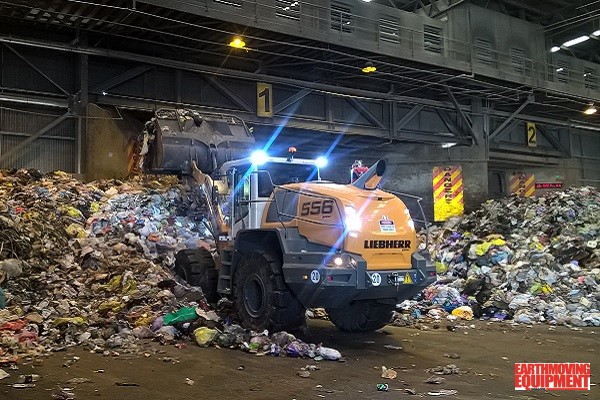We produce a lot of waste. Reports say the amount of rubbish that is managed in Australia every year is enough to cover the entire state of Victoria. Someone has to deliver customer satisfaction in this area and manage this waste – that’s where Veolia come in. But then to handle such a dauntingly immense task they require some serious machinery – and that’s where the innovative and highly powerful Liebherr wheel loader comes in.
Established 160 years ago, Veolia is a huge global organisation which operates in 48 countries around the world. It is the only global company to provide waste management, water management and energy services to municipal, industrial and commercial sectors.
In Australia Veolia has a history spanning over 40 years with environmental sustainability being the key driving force of its business strategy. They operate a wide range of processing facilities for the disposal, recovery and recycling of all materials, working out of more than 100 locations across Australia and New Zealand. One of their biggest services is their Resource Recovery Division, which, in New South Wales, is spearheaded by Justin Houghton, the Operations Manager.
“I am responsible for the operations of the Sydney facilities,” Justin begins to outline his role, “including Clyde and Banksmeadow Putrescible Waste Transfer Terminals, Port Botany and Greenacre Dry Waste Resource Recovery sites and the Horsley Park Dry Waste Landfill.”
At these various sites Veolia staff have to constantly move mountains of material. With their extremely high standards that match the intense demands of their workload, the company maintains stringent protocols that flow all the way through to the equipment they choose to use.
“Veolia is committed to continually improving our safety culture, supported by robust systems, processes and procedures,” continues Justin. “Our Always Safe charter underpins our safety performance and signals that we do not accept any compromises. This focus on safety extends into operational efficiency and our equipment procurement process also falls under this banner. It is imperative that we have safe, appropriate, task-specific, comfortable machines that are robust, efficient and easily maintained.”
After testing many machines, Veolia’s choice of loader became the Liebherr XPower. They now use these heavy-capacity, durable and highly efficient wheel loaders throughout their stations.
Mr Houghton further elaborates on how the range was introduced to their fleet, how the merger has developed and how supportive the supplier has been: “Liebherr were more than accommodating through the tender process, and their service and commitment didn’t stop there. Since awarded the contract they have worked closely with operations staff in making sure the machines are fit-for-purpose. They have been proactive in coming up with practical solutions when we request changes and their service is prompt and reliable.”
A real-world example of how Veolia currently use Liebherr loaders in working situations can be seen at their Clyde Transfer Terminal. This particular facility receives 500,000t of waste every year which needs to be pushed and loaded into compactors before being placed into 40-foot shipping containers, loaded onto a train and sent to Veolia’s own landfill location. There’s not many wheel loaders that can handle such hefty haulage, but Liebherr’s XPower driveline is more than capable. This revolutionary technology brings together both hydrostatic and mechanical drives, with the interaction between the two adjusting automatically depending on the given application. This system offers the optimal level of efficiency during loading and transport, as well as providing maximum acceleration and performance along all loading cycles, including on long routes and in the toughest of environments.
“When working in wet, slippery conditions that require good traction to achieve optimum operational outcomes,” Justin says, “the Liebherr hydrostatic drive has provided exceptional traction and torque which we have not seen in other machines.”
This technology also equates to low maintenance as there is less strain on all components. “Being hydraulically driven this means no gear boxes and it eliminates the constant grinding and wearing of mechanical parts,” Justin reiterates. Plus real-time, high-end data recording and analysis helps monitor and manage any fluctuations should they arise.
With Veolia being all about sustainability, low fuel consumption and emissions from their equipment is also important. Liebherr’s fuel-efficient drive concept reduces environmental impact and operating costs, something that hasn’t gone un-noticed on the books at Veolia, with their NSW Operations Manager reporting: “Liebherr’s claim of a significant reduction in fuel use has been realised with a measurable reduction of at least 20 per cent compared to historic fuel use on other brand machines at the sites.”
Justin admits that first bringing the new and somewhat foreign Liebherr loaders into their arsenal had its teething problems with “many operators apprehensive mainly due to the fact they did not have experience with this brand and were used to the mainstream brands”. Regardless of all the bells and whistles you throw at it, the bottom line is the end-user – the operator – is the one that has the last say as to whether a machine is worthy. Suffice it to say drivers at Veolia quickly changed their tune and became instant fans of the Liebherr XPower wheel loader.
“It has been a pleasure to see the change in our operator’s attitudes towards the Liebherr’s machines,” Justin concludes.
“All operators who operate these machines are extremely satisfied with the comfort, ease of operation and above all how the machines help them achieve their daily work schedules more efficiently and effectively than ever before.”
[colored_box color=”yellow”]For more information visit www.liebherr.com and www.veolia.com[/colored_box]





